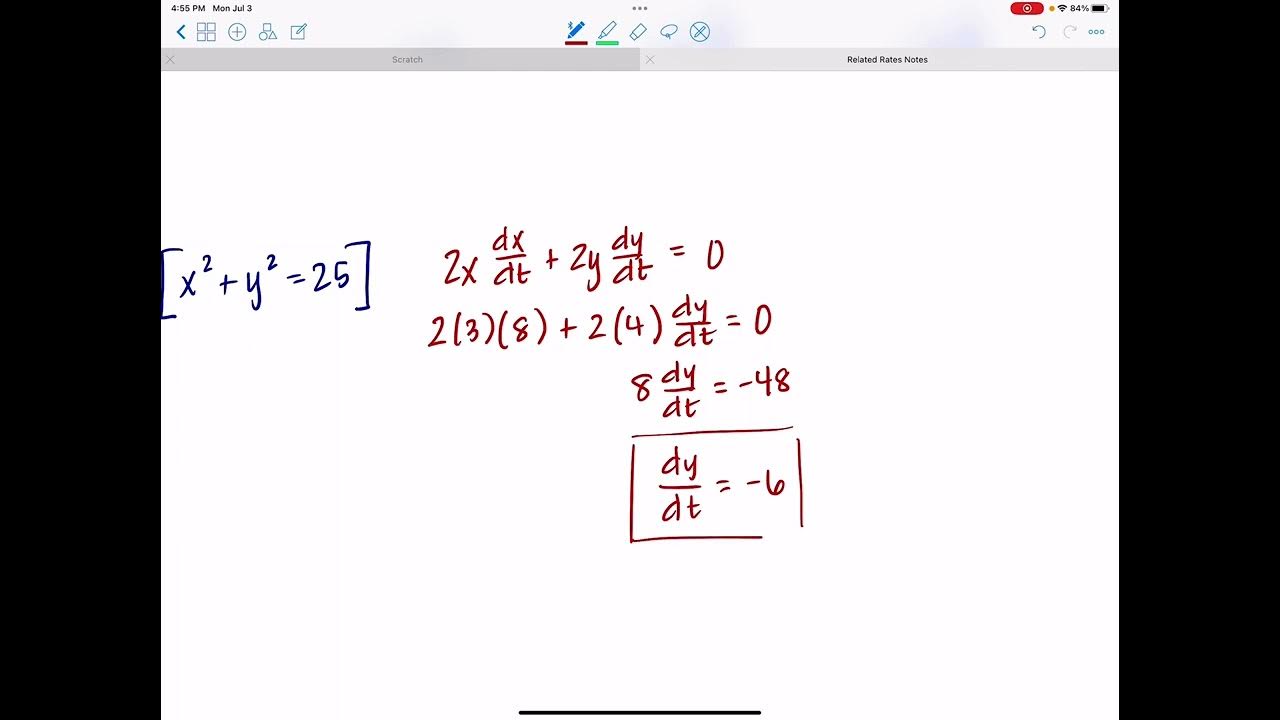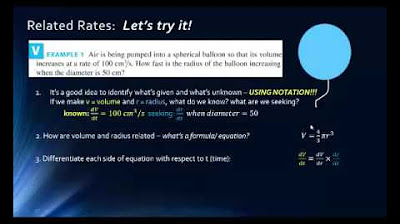Calculus AB/BC – 4.5 Solving Related Rates Problems
TLDRIn this educational video, Mr. Bean introduces viewers to the concept of related rates, guiding them through the process of setting up equations, taking derivatives with respect to time, and solving for unknown rates. He emphasizes the importance of understanding the context to determine the sign of the rate of change and provides clear examples involving a rectangle's area and a speeding car scenario to illustrate the steps and common pitfalls in solving related rate problems.
Takeaways
- 📝 The lesson focuses on solving related rates problems, which involve setting up equations with variables and using derivatives to find rates of change.
- 🔍 To begin, identify the variables and take their derivatives with respect to time, as demonstrated in the example with y squared and x cubed.
- 🧩 When information is incomplete, use the given values in the original equation to solve for the unknown variable, such as determining y from the equation y squared equals 3x to the fourth.
- 📈 It's crucial to consider the context of the problem to understand whether a variable's rate of change is positive or negative, as this affects the final solution.
- 🎨 Drawing a picture can help visualize the situation and label dimensions and quantities, which is recommended before taking derivatives.
- 📝 Make a list of all known and unknown rates and quantities to keep track of the information and identify what needs to be solved for.
- 🔧 Use the product rule when differentiating a product of variables, as seen in the example with the area of a rectangle changing over time.
- ⚠️ Avoid substituting non-constant quantities before taking the derivative, as this can lead to incorrect results.
- 📐 Apply the Pythagorean theorem to relate variables in the example of two moving cars, and differentiate the equation with respect to time to find the desired rate of change.
- 🔢 Substitute known quantities and solve for the unknown derivative, as demonstrated in the car chase example to find the speed of the speeding car.
- 💡 Practice is essential for mastering related rates problems; start with simpler examples and gradually tackle more complex scenarios.
Q & A
What is the main topic of the lesson?
-The main topic of the lesson is related rates, specifically how to set up equations, take derivatives with respect to time, and solve for unknown rates of change.
How does Mr. Bean introduce the concept of related rates in the script?
-Mr. Bean introduces the concept of related rates by discussing how to set up a relationship with variables and then take the derivative to solve for rates that are related to each other.
What is the first step in solving related rate problems according to the script?
-The first step in solving related rate problems, as outlined in the script, is to draw a picture and understand the situation to start labeling different dimensions and quantities involved.
What is the significance of the derivative in related rate problems?
-The derivative in related rate problems is significant because it represents the rate of change with respect to time. It is used to find how fast a quantity is changing at a given moment.
What is the importance of listing known and unknown rates and quantities?
-Listing known and unknown rates and quantities is important as it helps keep track of the information available and what needs to be determined. This list aids in setting up the correct equations and solving for the unknown rates.
Why is it not allowed to substitute a non-constant quantity before taking the derivative?
-Substituting a non-constant quantity before taking the derivative is not allowed because it can lead to incorrect results. The derivative represents a rate of change, and non-constant quantities are changing over time, so they should only be substituted after the derivative has been taken to accurately reflect their changing nature.
How does the script illustrate the concept of product rule in differentiation?
-The script illustrates the product rule in differentiation by showing that when two variables are multiplied, such as in the area of a rectangle (length times width), the derivative must be taken using the product rule. This involves differentiating each variable separately and then combining them according to the rule.
What is the key to solving for the rate of change in the area of the rectangle example?
-The key to solving for the rate of change in the area of the rectangle is to set up the equation for the area (length times width), take the derivative with respect to time using the product rule, and then substitute the known values and solve for the unknown rate of change of the area.
How does the script use the Pythagorean theorem in the car chase example?
-The script uses the Pythagorean theorem to relate the distances of the two cars from a fixed point (the intersection). It sets up the equation x^2 + y^2 = z^2, where x, y, and z represent the distances of the speeding car, the police car, and the increasing distance between them, respectively.
What is the final step in solving related rate problems?
-The final step in solving related rate problems is to substitute the known quantities and rates into the derivative equation derived from the relationship between the variables, and then solve for the unknown rate of change.
Outlines
📚 Introduction to Related Rates
This paragraph introduces the concept of related rates, focusing on how to set up and solve problems involving rates that are connected to each other. Mr. Bean explains that the first step is to establish a relationship between variables, take the derivative with respect to time, and then solve for the unknown rate. The example given involves finding the rate of change of y (dy/dt) when x equals 1 and dx/dt equals 2, using the equation y^2 = 3x^4. The process involves plugging in known values and solving for the unknown, which in this case results in dy/dt = 6.
📈 Solving Related Rates with Rectangles
This section delves into solving related rates problems using a geometric context—specifically, a rectangle. The focus is on understanding how the area of a rectangle changes over time as its dimensions change. The example provided involves a rectangle with an increasing width (dw/dt = 2 cm/s) and a fixed length (5 cm), aiming to find the rate of change of the area (da/dt) when the width is 4 cm. The solution process involves setting up the area formula (A = lw), differentiating with respect to time, applying the product rule, and plugging in known values to find the rate of change of the area, which is given as 12 + 10 * (dw/dt).
🚗 Chase Scene: Calculating Speed with Related Rates
This paragraph presents a more dynamic example of related rates, involving two moving objects—a speeding car and a police car. The goal is to find the speed of the speeding car (dx/dt) at a particular moment when specific distances are given. The setup uses the Pythagorean theorem to relate the positions of the cars (x, y, z) and their rates of change. The known values include the distance the speeding car is away from the intersection (x = 0.8 miles), the police car's position (y = 0.6 miles), and the rate at which the distance between them is increasing (dz/dt = 20 miles/hour). The solution involves differentiating the Pythagorean relationship, plugging in known values, and solving for the unknown rate, which is the speed of the speeding car at that moment, calculated to be 70 miles/hour.
Mindmap
Keywords
💡Related Rates
💡Derivative
💡Product Rule
💡Rectangle
💡Rate of Change
💡Context
💡Equation
💡Substitution
💡Non-constant Quantity
💡Units
💡Mastery Check
Highlights
Introduction to related rates problems and how to solve them.
Setting up the problem with variables and taking the derivative.
Solving for the rate of change when some variables are unknown.
Using the original equation to find the unknown variable's value.
Distinguishing between positive and negative rates of change based on context.
Guidelines for solving related rate problems, including drawing a picture and listing known and unknown rates.
The importance of differentiating with respect to time and relating variables in an equation.
Substituting known quantities and solving for the unknown rate.
Explanation of when not to substitute a non-constant quantity before taking the derivative.
Example of a rectangle with changing dimensions and finding the rate of change of its area.
Using the product rule for derivatives when dealing with multiplied variables.
Correctly identifying and using units in the solution.
Example involving a speeding car and police car, using the Pythagorean theorem to relate variables.
Differentiating the Pythagorean equation with respect to time and solving for the unknown rate of change.
Explanation of how to handle negative rates of change in the context of the problem.
Final example demonstrating the setup and solution of a related rates problem involving two moving objects.
Mastery check and summary of the key steps in solving related rates problems.
Transcripts
5.0 / 5 (0 votes)
Thanks for rating:





